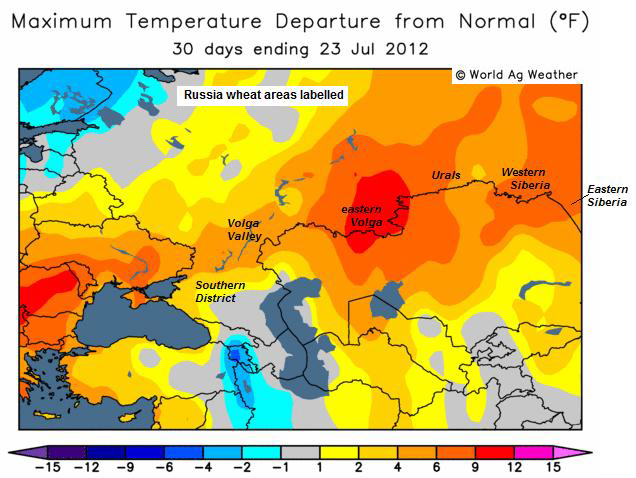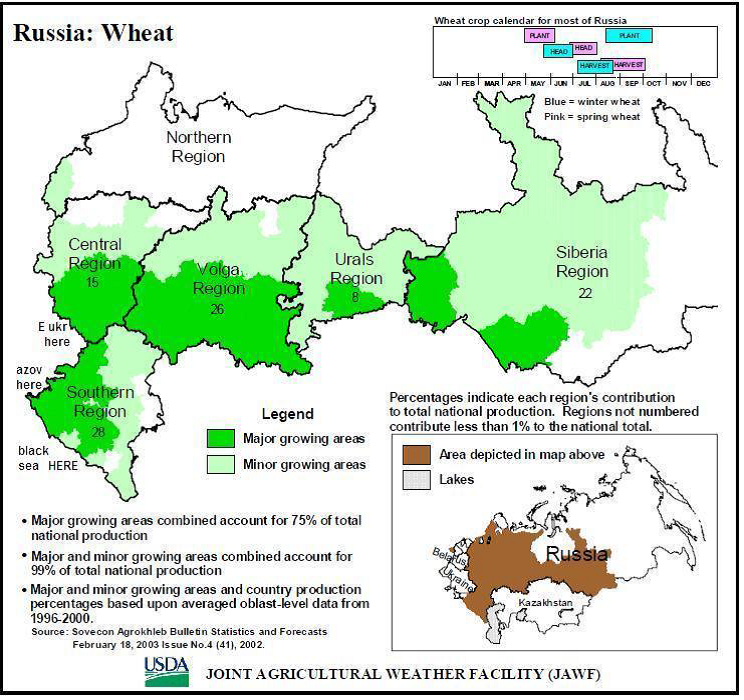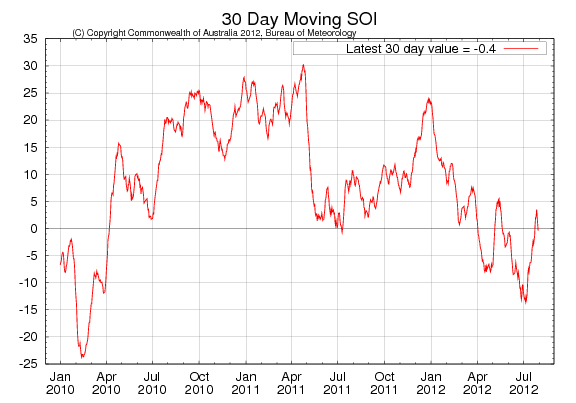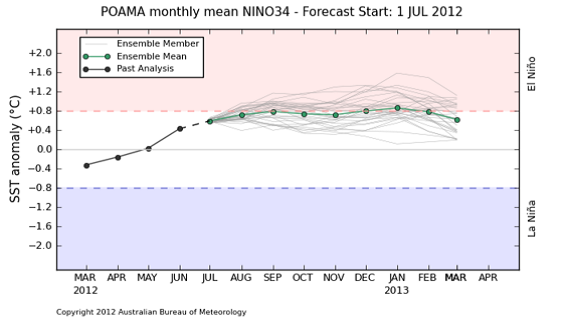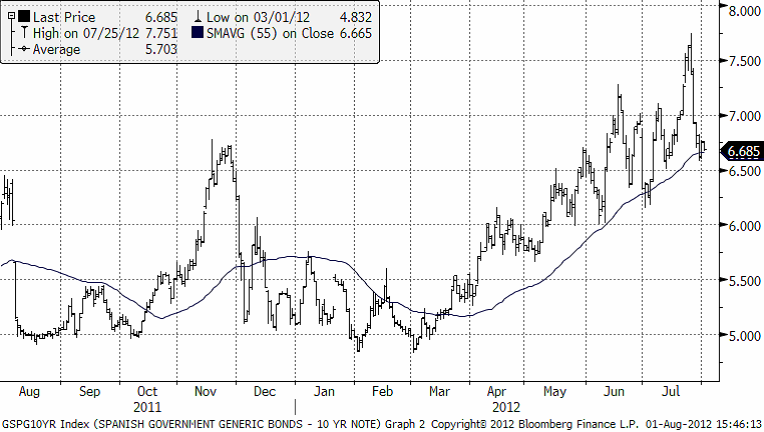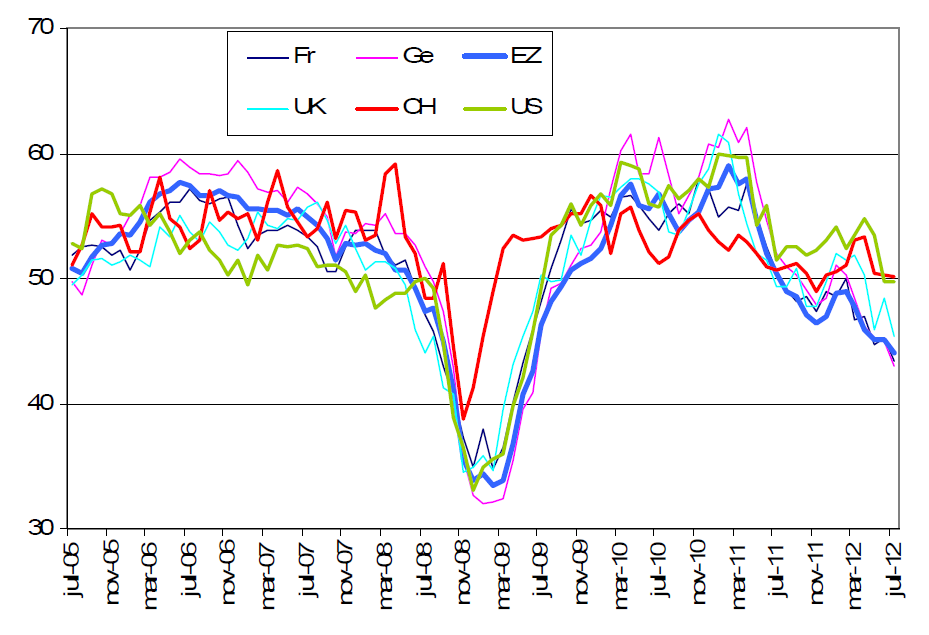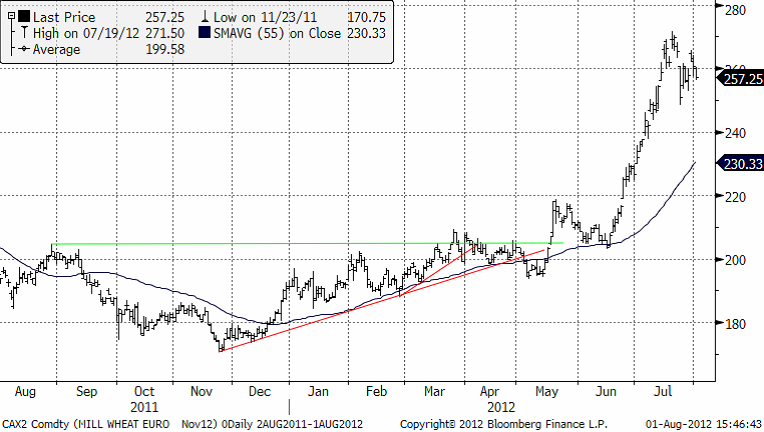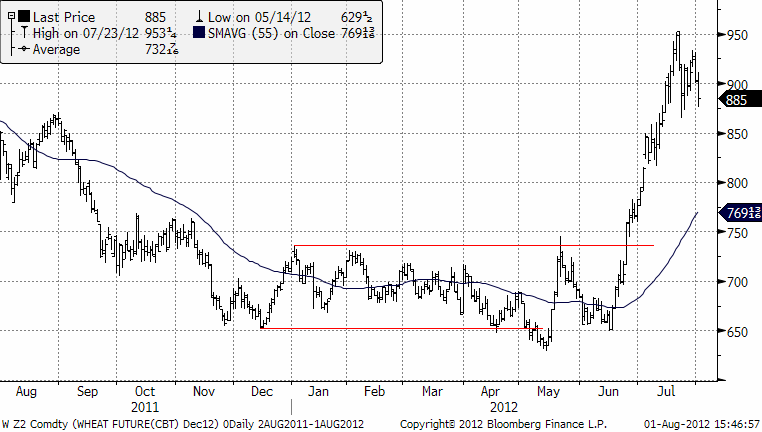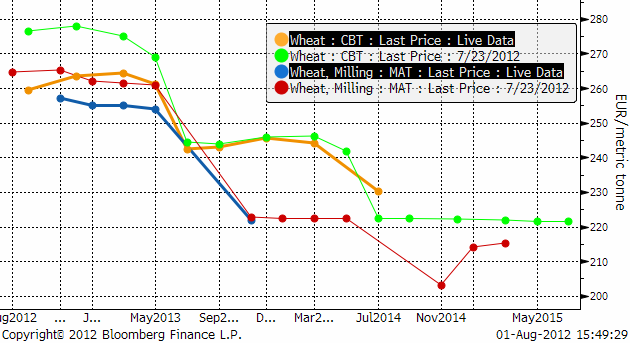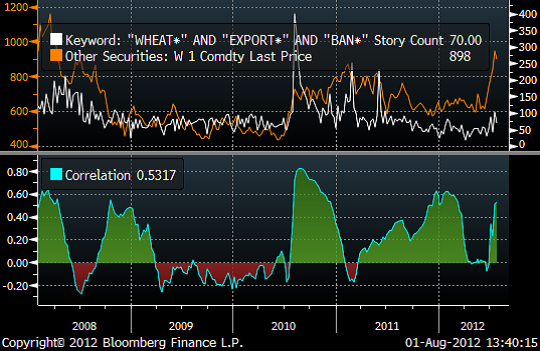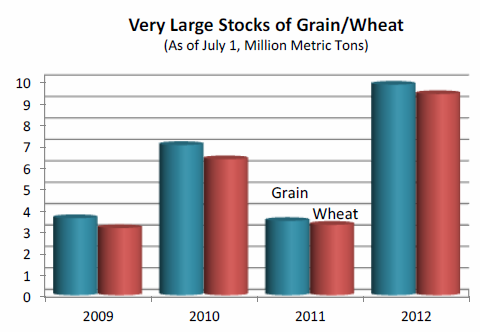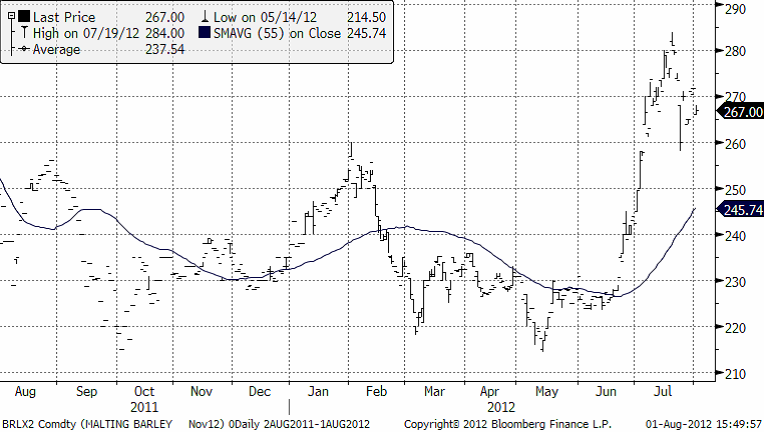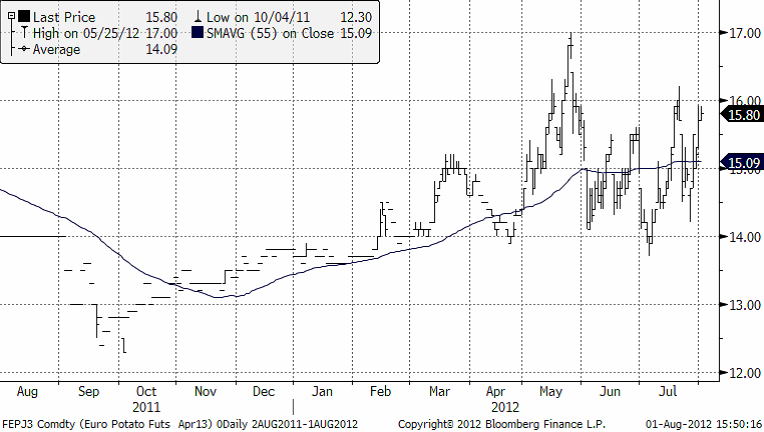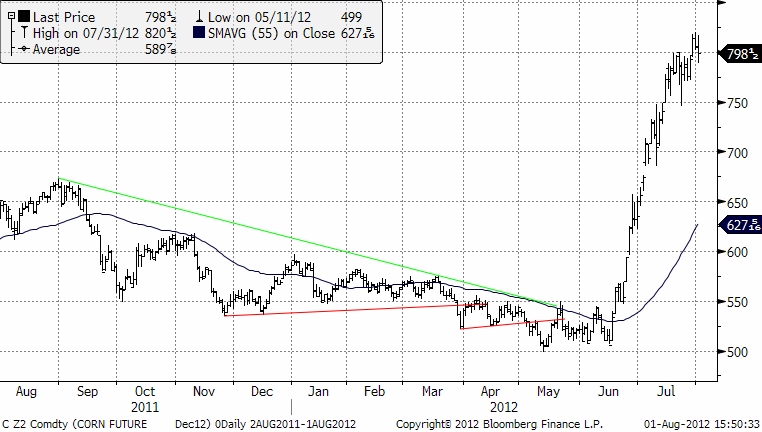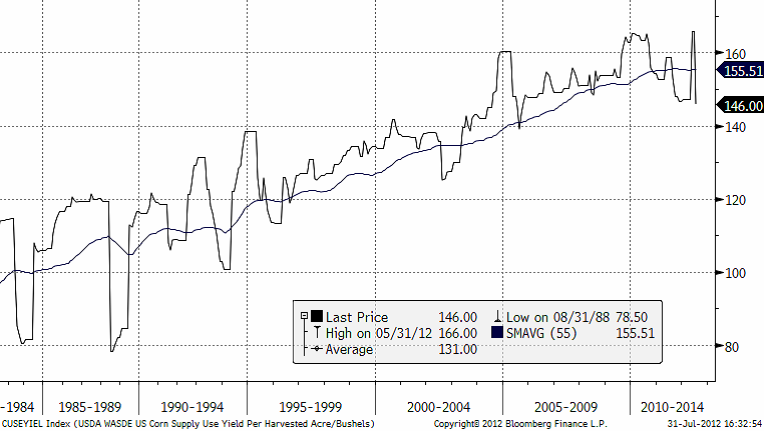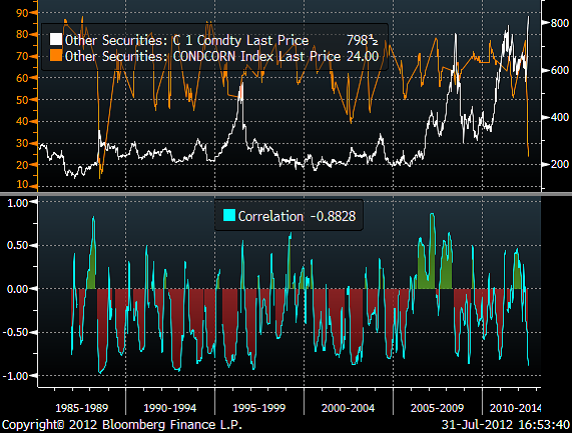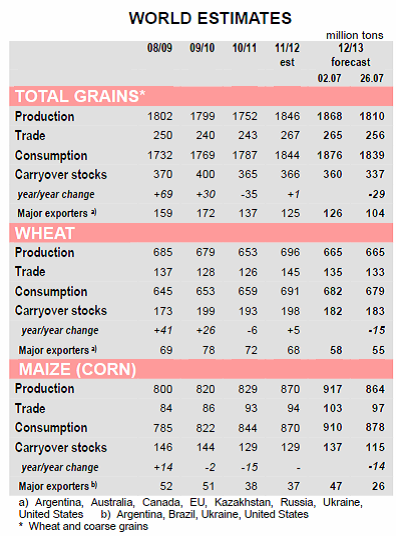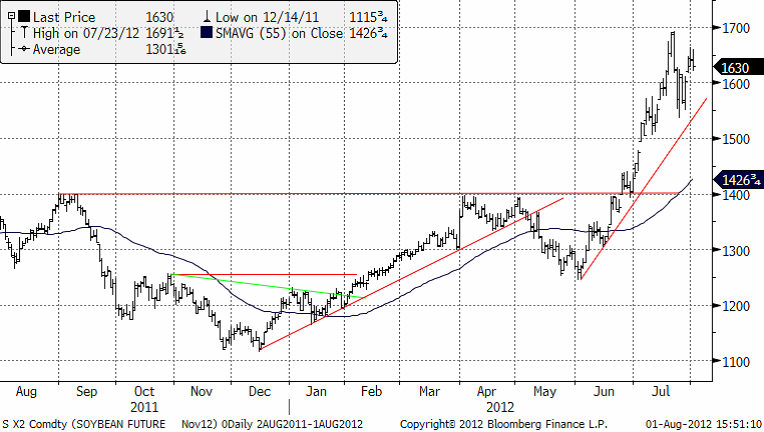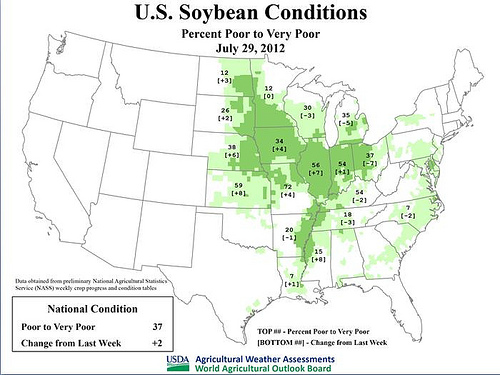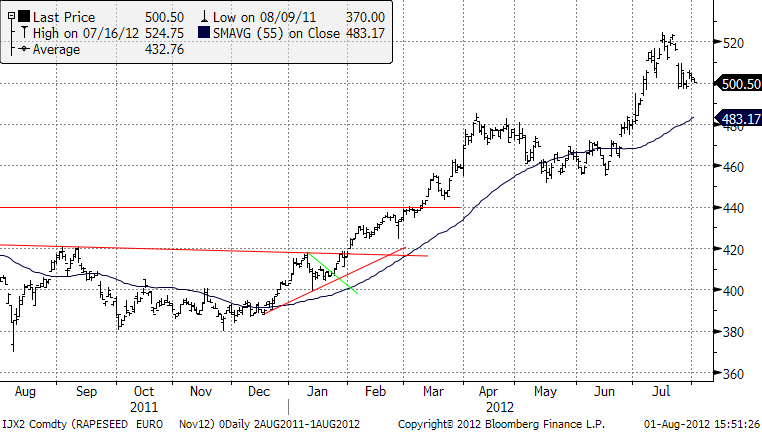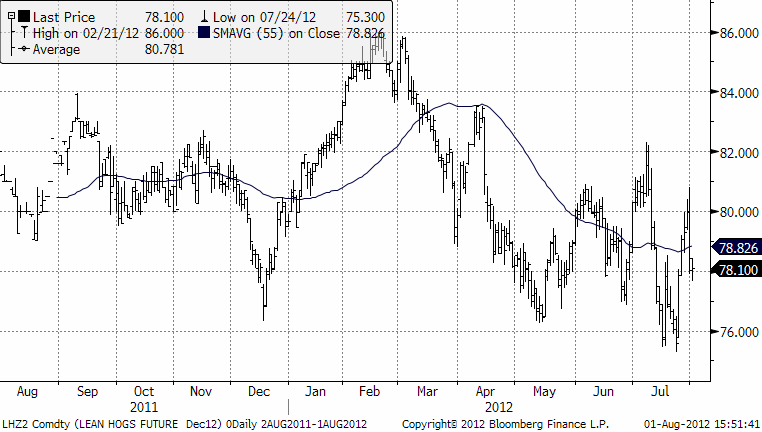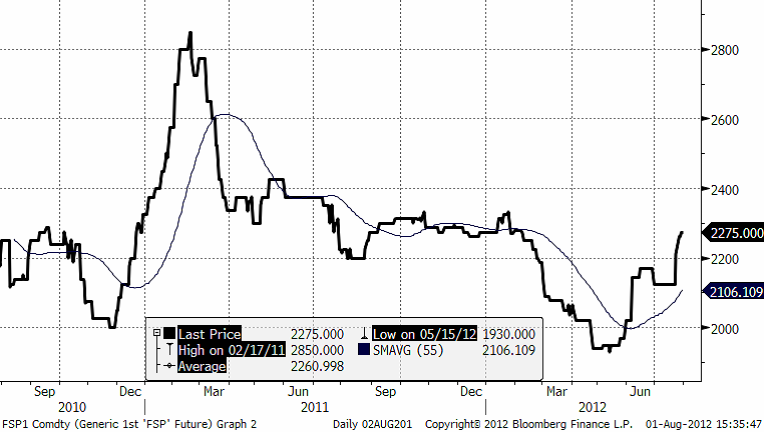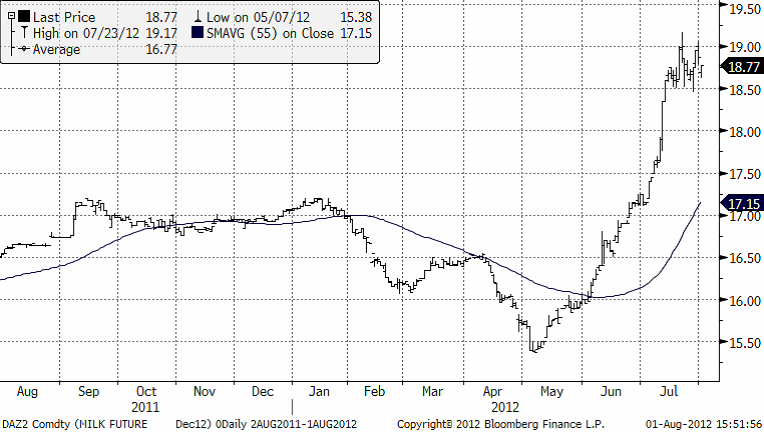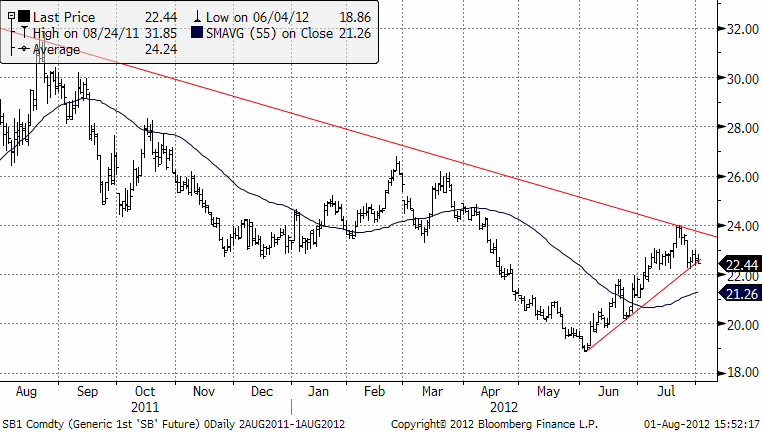Analys
SEB Jordbruksprodukter, 2 augusti 2012
 Inledning
Inledning
Den senaste veckan har priserna inte rört sig mycket. Även orderflödet har varit lugnare. Folk verkar ha stannat upp och funderat på vad som kommer att hända härnäst. På fredag nästa vecka publicerar USDA augustis WASDE-rapport. Kanske kommer det att vara lugnt fram tills den rapporten ger mer vägledning.
Vi fortsätter att ha en vy om högre priser på vete, maltkorn, majs, och sojabönor. Priset på socker står och väger, vid ett vägskäl, kan man säga.
Odlingsväder
Bilder på det varma vädret i Ryssland och Svartahavsområdet börjar komma ut nu. Nedan ser vi en kartbild publicerad av Martell Crop Projections.
Southern Oscillation Index har tagit sig upp till neutrala förhållanden igen, men det anses vara temporärt, eftersom de flesta prognosmodeller pekar på att ENSO ska vara nära El Niño-förhållanden, dvs med SOI närmare eller lägre än -8.
Australiensarnas prognos för ENSO pekar som vi ser nedan på att El Niño kan utveckla sig under hösten, men att det än så länge är osäkert. ENSO surfar precis på gränsen till El Niño.
Eurokrisen
Vad som sker i EU är att det finns en social acceptans att banker tas över av staten därför att man inte vill uppleva obehaget av att bankerna går under var och en för sig, Detta gör att det är rimligt att anta att staternas i fråga egentliga skulder är deras egen statsskuld + bankernas skulder. När man studerar den typen av skuldberg i förhållande till de här ländernas skatteintäkter, får man en skrämmande bild. Än så länge försöker man skjuta upp det oundvikliga. ECB:s satsning på att få ner räntorna i Spanien är det senaste och främsta exemplet på detta. Vi ser nedan hur räntorna har på deras tioårs statsobligation har fallit från 7.75 till 6.68. Förmodligen får vi se räntemarknaden ta ett nytt kliv uppåt inom kort. Skuldberg av den här storleken blir man av med genom att inte betala (skuldnedskrivning / konkurs) eller genom att betala med nytryckta pengar (inflation).
Inköpschefsindex, PMI, för de stora ekonomierna har sjunkit stadigt det senaste året. Tysklands PMI för tillverkningsindustrin ligger nu under Frankrikes, på 43 mot 43.4. Eurozonen ligger på 44. Storbritannien har bromsat in fort de senaste tre månaderna och har sjunkit från 50.2 i april till 45.4 i juli. USA har halkat under 50. Endast Kina ligger över 50. Gårdagens kinesiska PMI kom in på 50.1, vilket är en tiondel lägre än i juni (50.2). PMI anses vara en ”ledande indikator” för ekonomins utveckling.
PMI, som är en ledande indikator, är för Eurozonen på samma nivå som månaden före Lehmankraschen 2008.
Vete
Matifvetet med novemberleverans nådde upp till 271.50 den 19 juli, men har sedan dess rekylerat ner till 257.25 euro i skrivande stund. Det är en nedgång med undefär 2.5 euro sedan förra veckobrevet. Frågan är om det här är en konsolidering inför vidare uppgång eller en toppnivå? Vi tror att marknaden kan komma att röra sig sidledes ännu en liten tid, men att priset sedan kommer att gå ännu högre.
IGC (International Grains Council) kom med sin rapport i förra veckan. Den globala produktionen av vete 2012/13 beräknas uppgå till 665 mt, vilket är oförändrat från tidigare prognos men lägre än förra årets 696 mt. Prognosen för veteproduktionen i Ryssland och Kazakstan justeras ned med 4 mt till 45 mt respektive 3 mt till 12 mt, medan utsikterna för produktionen i Kina och Indien justeras upp. Globala vete lager i slutet på säsongen 2012/13 justeras upp med 1 mt till 183 mt, vilket dock kvarstår som ett fyra-årslägsta. Nedan ser vi Chicagovetet med leverans i december. Dollarn stärks hela tiden mot euron, som faller stadigt i takt med att euroland blir mindre värt. Därför tyngs prisutvecklingen i cent mer än på Matif. På den punkten, betänk också att eurons fall gör att jordbruksmarken faller i pris i dessa länder; kostnaden rent allmänt utom för drivmedel och gödsel, för att producera spannmål sjunker.
Nedan ser vi hur terminspriserna på Matif och Chicago förändrats den senaste veckan. Det är på terminer med kort löptid vi sett att priset gått ner. De längre terminspriserna är i praktiken oförändrade. Det är naturligt eftersom det är den här skörden just nu, som är föremål för osäkerhet om hur stor den blir.
Vi ser i terminskurvorna ovan att Chicago fortfarande ligger över Matif för alla löptider. Ska man prissäkra framåt i tiden ger Chicago alltså ett högre pris än Matif.
Antalet artiklar på global basis som handlar om wheat+export+ban minskade den senaste veckan till 70 artiklar. Förra veckan var det 102 artiklar.
Vi ser att när det blir populärt att prata om wheat+export+ban i nyheterna, stiger vetepriset mot riktigt höga höjder. En panel av indiska (delstats) ministrar träffades i tisdags för att diskutera torkan i landet. De värst drabbade områdena är Punjab, Haryana, Karnataka och delar av Maharashtra och Gujarat. Andra delar av landet har fått för mycket nederbörd och istället drabbats av översvämningar. Punjab och Haryana är stora producenter av ris, medan de västra delstaterna Maharashtra och Gujarat är betydande producenter av oljeväxter och bomull.
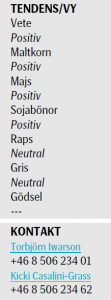 Centralbanken har också precis sänkt landets tillväxtprognos pga torkan. De åtgärder som ministrarna beslutade sig för var att öka stödet för dieselkonsumtion för jordbrukare, ökade stödet för utsäde. Man tog också bort importskatten på proteinmjöl. Man hade nämnt att man skulle diskutera att införa begränsningar i terminshandeln innan mötet, men detta gjorde man alltså inte. Skörden av linser, etc väntas bli avsevärt lägre i år än förra året, men landet har betydande lager sedan rekordskörden år 2007.
Centralbanken har också precis sänkt landets tillväxtprognos pga torkan. De åtgärder som ministrarna beslutade sig för var att öka stödet för dieselkonsumtion för jordbrukare, ökade stödet för utsäde. Man tog också bort importskatten på proteinmjöl. Man hade nämnt att man skulle diskutera att införa begränsningar i terminshandeln innan mötet, men detta gjorde man alltså inte. Skörden av linser, etc väntas bli avsevärt lägre i år än förra året, men landet har betydande lager sedan rekordskörden år 2007.
I Ryssland har den södra Krasnodar-regionen, en av få som nu är klara, skördat ca 5 mt spannmål, ungefär en tredjedel av förra årets skörd. På vissa ställen i västra Sibirien och Ural har temperaturen inte gått under 30 grader på över en månad, vilket också har lett till skogsbränder. Även om den ryska torkan är långt ifrån lika allvarlig som den i USA, har den extrema värmen fått landets jordbruksministerium att förra månaden sänka sin prognos för produktionen av spannmål till 80 mt, en minskning med 15 procent från förra året. I måndags sänkte Federal Metereorological and Environmental Monitoring Service sin prognos till 77 mt från 80 mt, något som förväntas följas av jordbruksministeriet. Ryssland behöver ca 72 mt spannmål för inhemska behov, och exporterar i allmänhet det som blir över. Oron över att Ryssland ska inför exportförbud eller exportrestriktioner kvarstår, men skulle kunna vara något som blir svårare för landet att införa i och med Rysslands inträde i WTO där reglerna för den globala handeln begränsar sådana genomföranden.
En nybildad kommission för tryggad livsmedelsförsöjning, som leds av Rysslands vice premiärminister Arkady Dvorkovich, kommer att träffas den 8 augusti för att diskutera spannmålssituationen i Ryssland.
Som ett resultat av det mycket torra vädret i vissa delar av Kazakstan förväntas landets spannmålsproduktion 2012 att sjunka kraftigt till drygt hälften av fjolårets rekordnivå. Men trots kraftigt minskad produktion, kommer sannolikt välfyllda lager att tillåta fortsatta höga exportvolymer under 2012/13. Per den 1 juli 2012 uppgick spannmåls-lagren till 9.8 mt, varav 9.4 mt vete.
Produktionen av vete förväntas sjunka till 12 mt, jämfört med rekordet på nästan 23 mt under 2011. Medan spannmålsarealen kvarstår stadigt på 16.3 miljoner hektar, ser man däremot betydande förändringar mellan grödor. Arealen för vete har sjunkit med 2%, medan den totala arealen för korn har ökat kraftigt med 140 000 hektar till 1.8 miljoner hektar med den största ökningen i de nordliga regionerna.
Torka i vissa norra delar av Buenos Aires, den provins där mer än hälften av all vete produceras, och i södra Cordoba provinsen i Argentina har börjat påverka 2012/13 års gröda, där lantbrukarna ännu inte är klara med sådden. Landet är världens 6:e största vete exportör och den största leverantören till grannlandet Brasilien. Regeringen uppskattar att landets lantbrukare kommer att så 3.8 miljoner hektar med grödan denna säsong, en minskning från 4.6 miljoner hektar förra säsongen. I förra veckan hade lantbrukarna sått 88% av den estimerade arealen, upp 9% från veckan innan. BAGE estimerar landets vete areal till 3,6 miljoner hektar och USDA beräknar Argentinas veteproduktion till 12 mt under 2012/13, en minskning från 14.5 mt förra säsongen.
Maltkorn
Novemberkontraktet på maltkorn ligger kvar över stödet på 260 euro. Så länge priset håller sig över den nivån tror vi att man bör avvakta med att sälja för att se om priset kan gå högre.
Potatis
Potatispriset för leverans nästa år, har fortsatt att röta sig i det prisintervall vi skrivit om tidigare, mellan 14 och 16 euro per deciton. Om priset går utanför intervallet är det en signal om att priset kan dra iväg, men så länge priset håller sig inom intervallet är 16 = högt pris och 14 = billigt pris.
Majs
Priset på decembermajs ligger nu kring 800 cent. Jämna siffror brukar dra till sig mycket handel, eftersom det är psykologiskt lättare för folk att lägga en order på ”800 cent”, än t ex ”792.25”. 800 cent är alltså ett motstånd. Det har gått mycket fort att handla upp priset och någon slags rekyl eller konsolidering ”borde” kunna äga rum.
Nedan ser vi den av USDA enligt WASDE-rapporterna väntade avkastningen i bushels per acre i USA.
Som vi ser är trenden stadigt uppåtriktad och Monsanto, t ex förutspår att det kommer att vara normalt med 300 bushels per acre år 2030. Längs vägarna i ”corn belt” kan man se skyltar som den reklamskylt vi ser nedanför:
Crop conditions rapporterades i måndags kväll som 24% av majsskörden i good eller excellent condition. Detta fick priserna naturligtvis att stiga ännu mer. Studerar vi förhållandet mellan crop condition och majspris ser vi att korrelationen över tiden mellan förändringar i crop condition och majspris är kraftigt negativ, som den borde vara. Vi ser detta nedan, med de faktiska noteringarna i den övre delen och korrelationen dem emellan i den nedre.
IGC (International Grains Council) kom med sin rapport i förra veckan och sänkte sin prognos kraftigt för den globala majsproduktionen 2012/13, med hänvisning till den värsta amerikanska torkan sedan 1956, och estimerar samtidigt att majslagren kommer att sjunka till ett sex-års-lägsta i slutet av säsongen. Den globala majsproduktionen beräknas nu uppgå till 864 mt, en nedjustering med 53 mt från tidigare prognos, vilket också är lägre än föregående säsongs 870 mt. Majsproduktionen i USA justeras ned med 50 mt till 300 mt, vilket är lägre än USDA’s senaste estimat på 329.5 mt.
Sojabönor
IGC (International Grains Council) kom med sin rapport i förra veckan (se tabellen ovan). Prognosen för den globala produktionen av sojabönor förväntas återhämta sig kraftigt under 2012/13, med en uppgång på 9% på årsbasis till 259 mt, även om prognosen hänger på en stark återhämtning av produktionen i Sydamerika där sådden börjar i fjärde kvartalet 2012. Däremot så justeras produktionen i USA ned med 8.3 mt till 79 mt. Nedan ser vi kursgrafen för november-bönorna. Vi ser att pristrenden är obruten uppåtriktad.
Nedan ser vi sojabönsodlarnas situation i USA. Det är ovanligt stora arealer som är i poor eller very poor condition. Andelen har ökat med 2%-enheter sedan förra veckan.
Celeres rapport visar att 41% av den brasilianska sojabönsskörden för 2012/13 har sålts, jämfört med 39% förra veckan och jämfört med 10% för ett år sedan. 97% av skörden 2011/12 har sålts, oförändrat från förra veckan och jämfört med 79% för ett år sedan.
Raps
Priset på novemberterminen befinner sig alltjämt i en obruten uppåtgående trend. 500 euro fungerar som ett starkt stöd. Skulle den nivån brytas finns nästa stöd på 480 euro.
Oil World höjer sin prognos för EU’s rapsproduktion, för andra gången på två veckor, till åtminstone 19.0 mt från tidigare 18.2 mt. Det blöta vårvädret har gynnat grödorna hos de ledande rapsproducenterna i Europa och den förväntade ökade avkastningen har justerats upp framförallt i Tyskland där produktionen beräknas uppgå till ca 4.9-5.0 mt och skörden där är nu avklarad till 20-25%. Produktionen i Frankrike beräknas uppgå till 5.4-5.5 mt, jämfört med förra årets 5.37 mt, utifrån en avkastning på 3.4-3.5 ton per hektar.
I Storbritannien däremot förväntas en minskning med 100 000 ton från förra årets rekordskörd på 2.7 mt, trots ökad sådd, men det är fortfarande oklart hur de senaste tidens kraftiga regn kommer att påverka grödorna. Med tanke på att rapsen noteras i euro, som är svag, kan man tänka sig högre priser (i euro) framöver.
Gris
Decemberkontraktet har etablerat ett bekräftat stödområde på 76 – 77 cent. Med högre foderkostnader och den minskande lönsamheten för grisproducenterna bör det finnas utsikter för ett högre pris på lean hogs.
Mjölk
Mjölkpriset drivs naturligtvis upp pga av torkan i USA och Ryssland, som även drabbar höproduktionen. Priset på skimmed milk powder på tyska börsen har fått från 1950 i maj till 2275 euro per ton idag, som vi ser i diagrammet för priset på spotkontraktet på tyska Eurex nedan.
Samtidigt kunde vi läsa på ATL.nu igår att Arla sänkt avräkningspriset till mjölbönder med motivationen ”Det är mycket, mycket mjölk i marknaden just nu och det pressar priserna hos alla bolag”.
På den amerikanska börsen, där torkan som drabbat foderproduktionen är mycket allvarligare än i Europa, har priset rusat. Nedan ser vi decemberkontraktet.
Socker
Priset på socker ligger fortfarande och balanserar: antingen bryts stödet och då för vi troligtvis en större prisnedgång mot 19 cent. – Eller så bryts motståndet som nu ligger på ca 23 cent, och då får vi antagligen en prisuppgång till 26 cent i första hand, kanske ännu mer.
[box]SEB Veckobrev Jordbruksprodukter är producerat av SEB Merchant Banking och publiceras i samarbete och med tillstånd på Råvarumarknaden.se[/box]
Disclaimer
The information in this document has been compiled by SEB Merchant Banking, a division within Skandinaviska Enskilda Banken AB (publ) (“SEB”).
Opinions contained in this report represent the bank’s present opinion only and are subject to change without notice. All information contained in this report has been compiled in good faith from sources believed to be reliable. However, no representation or warranty, expressed or implied, is made with respect to the completeness or accuracy of its contents and the information is not to be relied upon as authoritative. Anyone considering taking actions based upon the content of this document is urged to base his or her investment decisions upon such investigations as he or she deems necessary. This document is being provided as information only, and no specific actions are being solicited as a result of it; to the extent permitted by law, no liability whatsoever is accepted for any direct or consequential loss arising from use of this document or its contents.
About SEB
SEB is a public company incorporated in Stockholm, Sweden, with limited liability. It is a participant at major Nordic and other European Regulated Markets and Multilateral Trading Facilities (as well as some non-European equivalent markets) for trading in financial instruments, such as markets operated by NASDAQ OMX, NYSE Euronext, London Stock Exchange, Deutsche Börse, Swiss Exchanges, Turquoise and Chi-X. SEB is authorized and regulated by Finansinspektionen in Sweden; it is authorized and subject to limited regulation by the Financial Services Authority for the conduct of designated investment business in the UK, and is subject to the provisions of relevant regulators in all other jurisdictions where SEB conducts operations. SEB Merchant Banking. All rights reserved.
Analys
Tightening fundamentals – bullish inventories from DOE

The latest weekly report from the US DOE showed a substantial drawdown across key petroleum categories, adding more upside potential to the fundamental picture.

Commercial crude inventories (excl. SPR) fell by 5.8 million barrels, bringing total inventories down to 415.1 million barrels. Now sitting 11% below the five-year seasonal norm and placed in the lowest 2015-2022 range (see picture below).
Product inventories also tightened further last week. Gasoline inventories declined by 2.1 million barrels, with reductions seen in both finished gasoline and blending components. Current gasoline levels are about 3% below the five-year average for this time of year.
Among products, the most notable move came in diesel, where inventories dropped by almost 4.1 million barrels, deepening the deficit to around 20% below seasonal norms – continuing to underscore the persistent supply tightness in diesel markets.
The only area of inventory growth was in propane/propylene, which posted a significant 5.1-million-barrel build and now stands 9% above the five-year average.
Total commercial petroleum inventories (crude plus refined products) declined by 4.2 million barrels on the week, reinforcing the overall tightening of US crude and products.


Analys
Bombs to ”ceasefire” in hours – Brent below $70

A classic case of “buy the rumor, sell the news” played out in oil markets, as Brent crude has dropped sharply – down nearly USD 10 per barrel since yesterday evening – following Iran’s retaliatory strike on a U.S. air base in Qatar. The immediate reaction was: “That was it?” The strike followed a carefully calibrated, non-escalatory playbook, avoiding direct threats to energy infrastructure or disruption of shipping through the Strait of Hormuz – thus calming worst-case fears.

After Monday morning’s sharp spike to USD 81.4 per barrel, triggered by the U.S. bombing of Iranian nuclear facilities, oil prices drifted sideways in anticipation of a potential Iranian response. That response came with advance warning and caused limited physical damage. Early this morning, both the U.S. President and Iranian state media announced a ceasefire, effectively placing a lid on the immediate conflict risk – at least for now.
As a result, Brent crude has now fallen by a total of USD 12 from Monday’s peak, currently trading around USD 69 per barrel.
Looking beyond geopolitics, the market will now shift its focus to the upcoming OPEC+ meeting in early July. Saudi Arabia’s decision to increase output earlier this year – despite falling prices – has drawn renewed attention considering recent developments. Some suggest this was a response to U.S. pressure to offset potential Iranian supply losses.
However, consensus is that the move was driven more by internal OPEC+ dynamics. After years of curbing production to support prices, Riyadh had grown frustrated with quota-busting by several members (notably Kazakhstan). With Saudi Arabia cutting up to 2 million barrels per day – roughly 2% of global supply – returns were diminishing, and the risk of losing market share was rising. The production increase is widely seen as an effort to reassert leadership and restore discipline within the group.
That said, the FT recently stated that, the Saudis remain wary of past missteps. In 2018, Riyadh ramped up output at Trump’s request ahead of Iran sanctions, only to see prices collapse when the U.S. granted broad waivers – triggering oversupply. Officials have reportedly made it clear they don’t intend to repeat that mistake.
The recent visit by President Trump to Saudi Arabia, which included agreements on AI, defense, and nuclear cooperation, suggests a broader strategic alignment. This has fueled speculation about a quiet “pump-for-politics” deal behind recent production moves.
Looking ahead, oil prices have now retraced the entire rally sparked by the June 13 Israel–Iran escalation. This retreat provides more political and policy space for both the U.S. and Saudi Arabia. Specifically, it makes it easier for Riyadh to scale back its three recent production hikes of 411,000 barrels each, potentially returning to more moderate increases of 137,000 barrels for August and September.
In short: with no major loss of Iranian supply to the market, OPEC+ – led by Saudi Arabia – no longer needs to compensate for a disruption that hasn’t materialized, especially not to please the U.S. at the cost of its own market strategy. As the Saudis themselves have signaled, they are unlikely to repeat previous mistakes.
Conclusion: With Brent now in the high USD 60s, buying oil looks fundamentally justified. The geopolitical premium has deflated, but tensions between Israel and Iran remain unresolved – and the risk of missteps and renewed escalation still lingers. In fact, even this morning, reports have emerged of renewed missile fire despite the declared “truce.” The path forward may be calmer – but it is far from stable.
Analys
A muted price reaction. Market looks relaxed, but it is still on edge waiting for what Iran will do

Brent crossed the 80-line this morning but quickly fell back assigning limited probability for Iran choosing to close the Strait of Hormuz. Brent traded in a range of USD 70.56 – 79.04/b last week as the market fluctuated between ”Iran wants a deal” and ”US is about to attack Iran”. At the end of the week though, Donald Trump managed to convince markets (and probably also Iran) that he would make a decision within two weeks. I.e. no imminent attack. Previously when when he has talked about ”making a decision within two weeks” he has often ended up doing nothing in the end. The oil market relaxed as a result and the week ended at USD 77.01/b which is just USD 6/b above the year to date average of USD 71/b.

Brent jumped to USD 81.4/b this morning, the highest since mid-January, but then quickly fell back to a current price of USD 78.2/b which is only up 1.5% versus the close on Friday. As such the market is pricing a fairly low probability that Iran will actually close the Strait of Hormuz. Probably because it will hurt Iranian oil exports as well as the global oil market.
It was however all smoke and mirrors. Deception. The US attacked Iran on Saturday. The attack involved 125 warplanes, submarines and surface warships and 14 bunker buster bombs were dropped on Iranian nuclear sites including Fordow, Natanz and Isfahan. In response the Iranian Parliament voted in support of closing the Strait of Hormuz where some 17 mb of crude and products is transported to the global market every day plus significant volumes of LNG. This is however merely an advise to the Supreme leader Ayatollah Ali Khamenei and the Supreme National Security Council which sits with the final and actual decision.
No supply of oil is lost yet. It is about the risk of Iran closing the Strait of Hormuz or not. So far not a single drop of oil supply has been lost to the global market. The price at the moment is all about the assessed risk of loss of supply. Will Iran choose to choke of the Strait of Hormuz or not? That is the big question. It would be painful for US consumers, for Donald Trump’s voter base, for the global economy but also for Iran and its population which relies on oil exports and income from selling oil out of that Strait as well. As such it is not a no-brainer choice for Iran to close the Strait for oil exports. And looking at the il price this morning it is clear that the oil market doesn’t assign a very high probability of it happening. It is however probably well within the capability of Iran to close the Strait off with rockets, mines, air-drones and possibly sea-drones. Just look at how Ukraine has been able to control and damage the Russian Black Sea fleet.
What to do about the highly enriched uranium which has gone missing? While the US and Israel can celebrate their destruction of Iranian nuclear facilities they are also scratching their heads over what to do with the lost Iranian nuclear material. Iran had 408 kg of highly enriched uranium (IAEA). Almost weapons grade. Enough for some 10 nuclear warheads. It seems to have been transported out of Fordow before the attack this weekend.
The market is still on edge. USD 80-something/b seems sensible while we wait. The oil market reaction to this weekend’s events is very muted so far. The market is still on edge awaiting what Iran will do. Because Iran will do something. But what and when? An oil price of 80-something seems like a sensible level until something do happen.
-

 Nyheter3 veckor sedan
Nyheter3 veckor sedanStor uppsida i Lappland Guldprospekterings aktie enligt analys
-

 Nyheter4 veckor sedan
Nyheter4 veckor sedanBrookfield ska bygga ett AI-datacenter på hela 750 MW i Strängnäs
-

 Nyheter4 veckor sedan
Nyheter4 veckor sedanSommaren inleds med sol och varierande elpriser
-

 Nyheter4 veckor sedan
Nyheter4 veckor sedanOPEC+ ökar oljeproduktionen trots fallande priser
-

 Nyheter3 veckor sedan
Nyheter3 veckor sedanSilverpriset släpar efter guldets utveckling, har mer uppsida
-

 Analys4 veckor sedan
Analys4 veckor sedanBrent needs to fall to USD 58/b to make cheating unprofitable for Kazakhstan
-

 Nyheter4 veckor sedan
Nyheter4 veckor sedanTradingfirman XTX Markets bygger datacenter i finska Kajana för 1 miljard euro
-

 Nyheter2 veckor sedan
Nyheter2 veckor sedanUppgången i oljepriset planade ut under helgen


